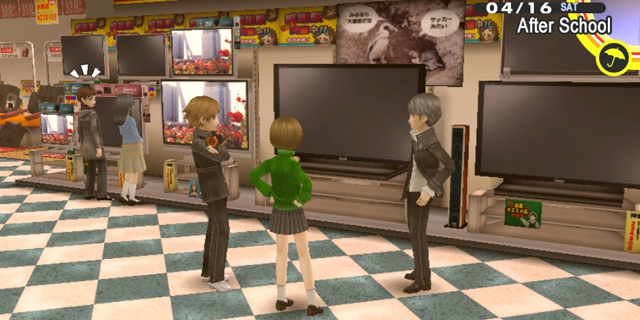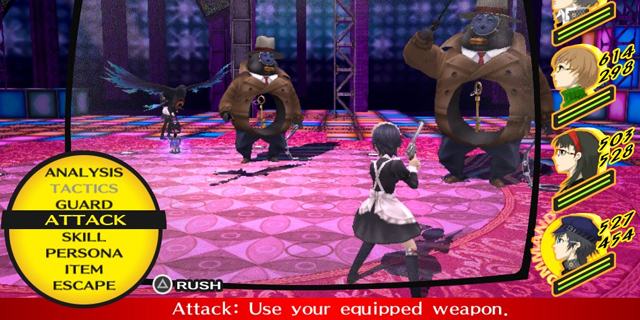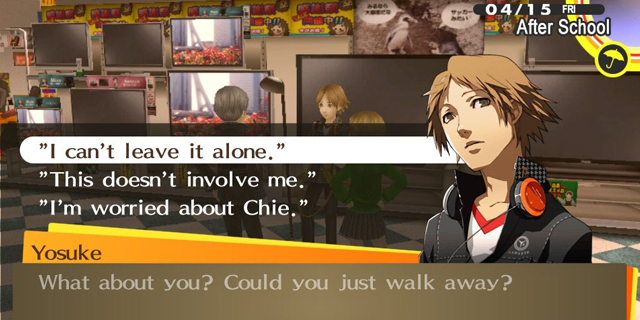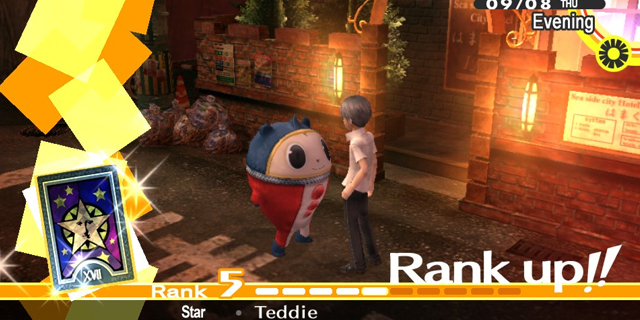
Not often can a game earnestly tout itself as a nigh-perfect package of gameplay, audiovisual presentation and narrative and, even if it can, there is usually some other critical flaw that it faces that sadly mars the overall experience. But, once in a very, very, very great while, some game passes through that gauntlet of development and reaches a state akin to Nirvana amongst games; a place where the true legends thrive and real gaming history is made and its players can count themselves truly privileged to have experienced it. This is where the game can stand with the classics of the other arts in a veritable pantheon of greatness.
One of these games is Persona 4 Golden.
Where do I even start? Persona 4: Golden may very well be the best RPG to come along since, well, the original Persona 4, and is high in the running, if not already secure for, my game of the year. The gameplay uses the standard turn-based RPG format often seen elsewhere, and polishes it to a mirror shine. It is almost as if the designers at Atlus took a magnifying glass to the archetypal battle system and specifically eliminated every flaw or shortcoming it could find. Battles are quick, satisfying and tactical, as opposed to certain situations that degrade into a “Tap A to Win” scenario. Each fight feels akin to an elegant dance, due to the game’s emphasis on stuns and type exploitation.

Online integration
It’s great to see a persistent Internet connection used in such an innocuous-yet-integral method as seen in Persona 4 Golden. Being able to tap a simple button at any time during the day and see the five most-commonly-chosen activities by other Golden players is a great way to weigh your options before making a decision. And, in the same manner, when deciding which of the plethora of Personas to fuse, being able to see the five most popular choices available to you helps you avoid the worthless fusions. – Shawn Vermette
It is a well-balanced system that never makes fights feel tiresome or repetitive. The ability to swap Personas without wasting a turn is nice and blends well with the game’s tactical system, as it does not punish you for being caught off-guard by random chance. Speaking of which, said Personas have grown in number to the largest collection the series has seen thus far, allowing for much more strategy and flexibility when fighting with or fusing them. One nice addition to the system in Golden is that when fusing Personas, you are allowed to choose which skills and spells get transferred over, as opposing to just hoping for the best in the original. It’s a minor change, but one that saves a lot of headache.
Moreover, minor gameplay changes are the name of the game in Golden, but each one of them solves real problems or inconveniences in the original, making for a game that’s as polished and well-made as it can possibly be. For example, in dungeons, as long as you come across the stairs during your trip to a floor, you can continue exploring the floor and advance to the next one with the touch of a button. Or, when planning what to do with your day, you can see what other P4G players did during that day, so you are never left feeling like you have wasted time.
All these things are mere extras to an already excellent package, but as long as they are well-implemented (and they are), then the more, the merrier. Also, the new system for calling for a lifeline when near death in a dungeon is an absolute life-saver on higher difficulties. As for the other half of what constitutes a modern Persona game, the social link mechanic and personality stats have been streamlined and made more approachable. These changes may seem like nothing, but to someone who has played Persona before, they add up, and make for a noticeably more fluid and enjoyable gaming experience, taking out a great deal of the hassles and uncertainty that pop up in the original.

Story and characters
Considering how quickly I became addicted to the characters in Golden, I find myself at a loss as to why I didn’t get into Persona 4 when I played it on the PlayStation 2. The flow of the game lends itself to taking advantage of my already-abused tendency to tell myself “one more turn” in turn-based strategy games. I find myself saying “one more activity” over and over again, until it’s 3 a.m. and I have to wake up for work in four hours. – Shawn Vermette
As for the story, it’s still the same great tale told as in the original, albeit with a few extra additions. People are being killed when they are thrown into an alternate reality existing inside the world’s televisions, and it’s up to you and your friends to discover the killer. It’s really the characters that make P4 shine, with a stunning localization and top-notch, believable voice acting that really sells the experience to the player.
The majority of P4’s voice actors reprise their original roles, and perform their lines masterfully. The game actually stars some great talent such as Yuri Lowenthal as Yousuke, Troy Baker as Kanji (my personal favorite out of the bunch), Laura Bailey as Rise and Johnny Yong Bosch as Johnny Yong Bosch in Johnny Yong Bosch’s Bosch-tastic Adventure. The great cast can really help you get lost in the world, enticing you to keep playing just to hear more of the story. With one exception, that is. As small of a problem as it may be, it ends up being Persona 4: Golden’s most irritating trait and the only step back from the original.
Two characters were given new voices in P4G: Teddie and Chie. Teddie’s new voice actor is top-notch, understanding the silly nature of the character and having a lot of fun with the role. I would easily prefer him to Teddie’s old voice actor. He’s just excellent at voice work. Chie’s voice actress, on the other hand, is not. Chie’s original voice was delivered with such a natural air that it made her character extremely likeable; she sounded exactly like a normal high school girl would sound like. The new Chie is much more whiny, annoying and delivers her lines with such grating over-the-top bravado that it’s impossible to take her seriously. It’s quite vexing and lessens her efficacy as a character. That said, it’s a rather minor blemish on an otherwise almost perfect game. One more thing: I want to commend Atlus for including some meaningful and well-developed LGBT characters in their game. It’s a wonderful thing to see, and a real stand-up act on Atlus’ part.

New aesthetic
As this is my first real exposure to Persona 4, I was surprised to hear that the aesthetics had changed appreciably from the original. After seeing some videos of the old look, I have to say I’m very glad for the switch. It wasn’t bad before, but now it just feels like it perfectly matches the overall tone of the game. Yes, it’s a somewhat dark story, but in general, the characters are optimistic and lighthearted. Just what you’d expect from a group of high school friends. And, of course, the dizzyingly-eclectic musical styles also work better with this feel. – Shawn Vermette
One rather interesting change I saw to the game’s narrative actually came by way of a change in visual aesthetic, as it made a rather unexpected impact on how the game is viewed. The original’s aesthetic borrowed its design heavily from its predecessor, Persona 3, with striking solid colors and harsh lines against black backgrounds. Persona 4 used yellow as its principal color in the game’s design; set against the black background, it looked like someone turning on a light in a dark room, which may have been metaphoric to the game’s central mystery and, tangentially, its use of fog.
Persona 4: Golden, however, takes the original’s aesthetic, considered lighthearted by Persona’s standards, and takes it even further, with the end result looking like the ’60s version of the ’00s filtered through the energy of the ’80s. Lots of colors adorn the UI design and, perhaps most telling, the new intro, which explodes with color and pep in every frame. It’s about as far away as you can get from the series’ roots (and makes for a jarring shift to watch the intros to Persona 1 and Persona 4: Golden back-to-back), but I don’t think that’s necessarily a bad thing. I’m not sure if I like the new style, per se, as it can feel grossly inappropriate given some of the game’s subject matter, but considering that the story additions to P4G are also fun and lighthearted (such as snowboarding and motor scooters), I would be lying if I said it didn’t fit with the revised version of the game. Take it for what it’s worth, I suppose.
The game’s aural presentation remains as some of the best in Japanese development, complements of the immensely talented Shoji Meguro, lending her hand to create several new tracks for Golden. They’re nothing new by Meguro standards, utilizing elements of Jazz, Rap, Rock and Pop to create something thoroughly unique, but the fact that you simply can’t find this kind of music anywhere else makes it more than forgivable. Sound effects are virtually unchanged from the original, using distinct, almost cartoonish qualities that actually fit in better with the revised visual aesthetic.
Persona 4: Golden is a phenomenal game. It’s something every Vita owner needs to have in their collection and is the best example of a system-seller Sony’s troubled handheld has seen thus far. If you own a Vita and have yet to play Persona 4, I can say without a hint of facetiousness that you need to stop what you’re doing and go get this game right now. If you don’t own a Vita and love Japanese RPGs, then it’s time to start saving up. Persona 4: Golden is not an experience to be missed. It is an absolute masterpiece, and should not be ignored by any gamer. I love this game; I love it more than any game I’ve played in a long, long while.
Pros: Great story, great battles, great additions
Cons: New voice acting and aesthetic may not be all positive



















